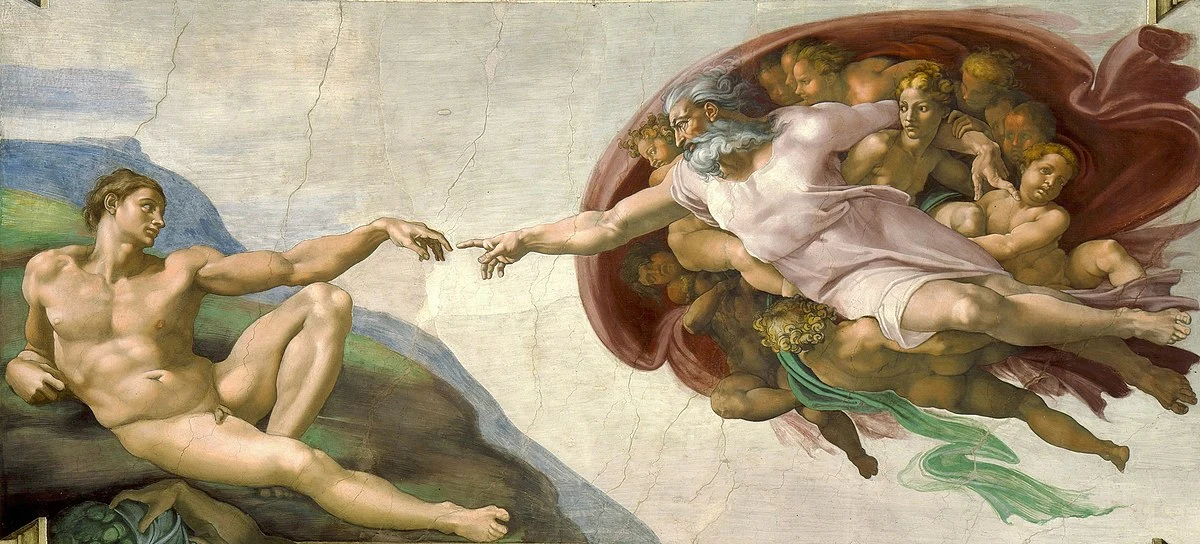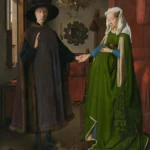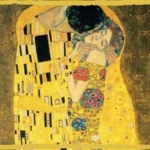
“The Creation of Adam,” painted by Michelangelo on the ceiling of the Sistine Chapel, is one of the most famous works of art in history. Completed during the Italian Renaissance, this iconic fresco captures the biblical moment when God gives life to Adam, symbolizing the profound relationship between humanity and the divine. With its innovative techniques, grand scale, and deep theological implications, the fresco has left an indelible mark on art and culture, inspiring countless interpretations and reproductions over the centuries.
Artist: Michelangelo Buonarroti is one of the most celebrated artists of the Italian Renaissance, known for his exceptional skills in sculpture, painting, and architecture. Born on March 6, 1475, in Caprese, Italy, Michelangelo was a polymath whose works have had a profound influence on Western art. His ability to convey human emotion and physicality in his figures set him apart from his contemporaries. “The Creation of Adam” is one of his most famous works, showcasing his mastery of the human form and his innovative use of composition.
Year Completed: The fresco was completed in 1512, marking a significant achievement in Michelangelo’s career and the High Renaissance period. Commissioned by Pope Julius II, the project was part of a larger effort to renovate the Sistine Chapel, which was originally built in the late 15th century. The completion of the fresco came after four years of intense labor, during which Michelangelo faced numerous challenges, including working on scaffolding high above the chapel floor. This year signifies not just the completion of a masterpiece but also the culmination of Michelangelo’s artistic vision during a transformative era in art history.
Location: “The Creation of Adam” is located on the ceiling of the Sistine Chapel in Vatican City, a site of immense religious and cultural significance. The chapel serves as the papal chapel and is used for important ceremonies, including the papal conclave. The ceiling itself measures about 40 meters (131 feet) long, and Michelangelo was tasked with painting it, which included nine central panels depicting scenes from Genesis. The fresco is positioned in the center of the ceiling, drawing the viewer’s eye and serving as a focal point of the entire composition.
Dimensions: The fresco measures approximately 280 cm × 570 cm (about 9 ft 2 in × 18 ft 8 in), making it one of the largest and most ambitious frescoes of its time. Its large scale allows for intricate details and a dynamic composition, which are hallmarks of Michelangelo’s style. The size of the work also emphasizes the grandeur of the biblical narrative it depicts, inviting viewers to contemplate the profound themes of creation and divine intervention. This expansive dimension contributes to its impact, making it a defining piece of Renaissance art.
Commission: The fresco was commissioned by Pope Julius II, a patron known for his ambitious artistic projects and his desire to restore the glory of the papacy. Julius II, who reigned from 1503 to 1513, was a significant figure in the Renaissance, often referred to as the “Warrior Pope” for his military and political maneuvers. His commission of the Sistine Chapel ceiling was part of a broader campaign to beautify the Vatican and assert the Church’s dominance in art and culture. The choice of Michelangelo for this monumental task highlights the Pope’s appreciation for the artist’s unique talent.
Subject Matter: The fresco depicts the biblical creation narrative from the Book of Genesis, specifically the moment when God gives life to Adam. This scene is rich in theological symbolism, illustrating the relationship between the divine and humanity. The imagery captures the moment of creation, where God’s outstretched hand reaches toward Adam, who is depicted in a relaxed posture. This moment reflects the concept of divine grace and the impartation of life, making it a profound representation of human existence and the connection to the divine.
Figures: The central figures in the fresco are God and Adam, each rendered with incredible detail and expressiveness. God is portrayed as an elderly, bearded man, embodying wisdom and authority, surrounded by a host of angels. In contrast, Adam is depicted as a youthful, muscular figure, symbolizing the potential of humanity. The dynamic interaction between the two figures, with their hands almost touching, creates a sense of tension and anticipation, emphasizing the significance of the moment. This composition has become one of the most recognizable images in art history.
Iconic Pose: The image of God reaching out to Adam is one of the most iconic images in Western art and has permeated popular culture. The outstretched hands of both figures create a powerful visual connection, suggesting the transmission of life and the divine spark. This pose has been widely reproduced and referenced in various forms of media, symbolizing the relationship between humanity and the divine. The simplicity yet profundity of the gesture has made it an enduring symbol of creation and inspiration.
Color Palette: Michelangelo employed a vibrant color palette in “The Creation of Adam,” utilizing rich blues, reds, and greens to create depth and drama. The use of color not only enhances the visual appeal of the fresco but also serves to convey emotion and highlight the significance of the scene. The vibrant colors contribute to the overall dynamism of the composition, drawing the viewer’s eye to the central figures of God and Adam. Michelangelo’s skillful blending of hues and use of chiaroscuro (the contrast of light and shadow) adds a three-dimensional quality to the figures, making them appear lifelike and engaging. This careful attention to color and light enhances the spiritual atmosphere of the fresco, inviting contemplation of the divine act of creation.
Technique: The fresco technique involves applying water-based paint onto freshly applied plaster, a method that requires speed and precision. Michelangelo faced considerable challenges while working on the ceiling, including the physical strain of painting at great heights and the need to complete the work before the plaster dried. This technique allows the paint to bond with the wall, creating a durable and long-lasting image. Michelangelo’s mastery of this method is evident in the intricate details and vibrant colors of “The Creation of Adam.” The fresco reflects his innovative approach and his ability to adapt to the constraints of the medium, resulting in a work that has stood the test of time and continues to captivate audiences today.
Influence: “The Creation of Adam” has significantly influenced countless artists and is often regarded as a symbol of the Renaissance. Its composition and themes have inspired various interpretations in painting, sculpture, and even modern media. Artists such as Raphael and later Baroque painters drew upon Michelangelo’s work, emulating his style and the emotional depth he conveyed. The fresco’s impact extends beyond the art world, influencing literature, film, and popular culture, where references to the iconic image of God and Adam continue to resonate. Its universal themes of creation and the divine spark have made it a lasting legacy in Western art.
Restoration: The Sistine Chapel underwent significant restoration from 1980 to 1994, a project aimed at cleaning and preserving Michelangelo’s frescoes, including “The Creation of Adam.” During the restoration, layers of grime, soot, and previous restorations were carefully removed, revealing the original vibrancy of the colors that had been obscured over centuries. The restoration process was controversial, sparking debates among art historians and critics regarding the authenticity of Michelangelo’s original vision. Ultimately, the cleaning revealed a brighter, more vivid palette, allowing viewers to appreciate the fresco’s full impact as Michelangelo intended.
Visitors: The Sistine Chapel attracts millions of visitors each year, with estimates around 6 million annually. This influx of tourists makes it one of the most visited cultural sites in the world. Visitors come from all corners of the globe to witness the breathtaking artistry of the chapel, particularly “The Creation of Adam.” The experience of viewing such a renowned work of art in its original context adds to its allure, as visitors can appreciate the scale and intricacies of Michelangelo’s masterpiece firsthand. The chapel’s role as a site of religious significance further enhances its importance as a destination.
Symbolism: The outstretched hands of God and Adam in “The Creation of Adam” are rich in symbolism, representing the transmission of life and divine grace. This moment captures the essence of creation, where God’s gesture signifies the bestowal of life upon humanity. The slight gap between their fingertips suggests the idea of potential and the connection that exists between the divine and human realms. The imagery invites viewers to reflect on themes of existence, free will, and the relationship between creator and creation, making it a profound theological statement as well as an artistic achievement.
God’s Appearance: In the fresco, God is depicted as an elderly, bearded figure, embodying wisdom, power, and authority. He is surrounded by a group of angels, which enhances the sense of divine presence. The flowing robes and dynamic pose of God convey movement and energy, suggesting the act of creation in progress. This portrayal contrasts with the youthful and relaxed figure of Adam, emphasizing the difference between the divine and human nature. The composition highlights the grandeur of God, reinforcing the theme of divine intervention in the act of creation and the significance of humanity’s existence.
Adam’s Posture: Adam is shown reclining in a relaxed posture, symbolizing passivity and the act of receiving life. His muscular form reflects the idealized human figure, a hallmark of Renaissance art, and suggests strength and potential. The contrast between Adam’s relaxed position and God’s dynamic gesture creates a powerful visual dialogue, emphasizing the moment of creation. This portrayal also invites viewers to consider the nature of humanity—created in the image of God but dependent on the divine for life. Adam’s posture serves as a reminder of the human condition, balancing the themes of divinity and mortality.
Cultural Impact: The fresco has been referenced in various forms of popular culture, including films, advertisements, and literature. Its iconic imagery has transcended the art world, becoming a universal symbol of creation and the divine. For instance, scenes inspired by “The Creation of Adam” have appeared in movies such as “The Matrix” and various television shows, often used to evoke themes of enlightenment and awakening. The widespread recognition of the fresco’s imagery demonstrates its enduring relevance and ability to resonate with contemporary audiences, bridging the gap between historical art and modern expression.
Artistic Style: “The Creation of Adam” exemplifies the High Renaissance style, characterized by balance, harmony, and a focus on humanism. This period marked a shift towards a more naturalistic representation of the human form, with artists striving for realism and emotional expression. Michelangelo’s use of anatomical precision and dynamic poses reflects this artistic evolution, showcasing his deep understanding of human anatomy. The composition’s symmetry and spatial organization further underscore the principles of the High Renaissance, creating a harmonious visual experience that invites contemplation and admiration.
Historical Context: “The Creation of Adam” is a significant fresco painted by Michelangelo on the ceiling of the Sistine Chapel during the Italian Renaissance, a cultural movement that spanned the 14th to the 17th century. This period marked a resurgence of interest in classical antiquity, emphasizing humanism, art, and science. Artists sought inspiration from ancient Greek and Roman works, leading to groundbreaking advancements in techniques and perspectives. Michelangelo’s work is a prime example of this era’s artistic innovation, reflecting the Renaissance ideals of beauty, proportion, and the human experience.
Influence on Theology: The imagery depicted in “The Creation of Adam” has sparked extensive theological discussions regarding the nature of humanity and divinity. The painting illustrates the biblical story of God giving life to Adam, which raises profound questions about the relationship between the Creator and His creation. The nearly touching fingers of God and Adam symbolize the moment of divine inspiration and the impartation of the soul. This interaction has been interpreted as a representation of the potential for a direct relationship between humanity and the divine, emphasizing themes of grace, free will, and the inherent dignity of human beings.
Mural Technique: Michelangelo’s approach to painting the Sistine Chapel ceiling was revolutionary, particularly the scaffolding system he employed. Unlike traditional methods, which often involved painting from the ground up, Michelangelo designed a unique scaffolding that allowed him to work directly above him, providing greater access to the expansive ceiling. This innovative technique not only facilitated the intricate detailing and large-scale composition of the frescoes but also set a new standard for mural painting, influencing generations of artists. His mastery in fresco technique, where pigments are applied to wet plaster, ensured that the colors would remain vibrant for centuries.
Fresco Size: The Sistine Chapel ceiling, which encompasses approximately 1,000 square meters (10,764 square feet), is one of the largest and most significant artistic undertakings of the Renaissance. Within this vast space, Michelangelo painted over 300 figures, each carefully composed to convey complex narratives from the Book of Genesis. The sheer scale of the frescoes, including “The Creation of Adam,” showcases not only Michelangelo’s artistic genius but also the ambitious vision of the Catholic Church during this period. The size and grandeur of the ceiling have made it a focal point for visitors and art enthusiasts from around the world.
Art Market Value: While “The Creation of Adam” itself is not for sale, the art market has seen similar works by Michelangelo fetch millions at auction. His sculptures and paintings are highly coveted, and works attributed to him or inspired by his style often command astronomical prices. For instance, pieces like the “Pietà” or “David” have become iconic representations of Renaissance art, contributing to Michelangelo’s status as one of the greatest artists in history. The value of his artwork reflects not only its artistic merit but also its cultural significance and the ongoing fascination with his contributions to art and humanity.
Representation of Humanity: “The Creation of Adam” is often interpreted as a profound representation of the relationship between God and humanity. The nearly touching hands of God and Adam create a dynamic tension, symbolizing the moment of creation and the divine spark of life. This imagery has been widely analyzed and celebrated for its exploration of themes such as individuality, the human condition, and the quest for knowledge. Michelangelo’s ability to convey emotion and physicality through his figures allows viewers to reflect on their own existence and the spiritual connections that transcend the physical realm.
Legacy: Since its completion, “The Creation of Adam” has evolved into a cultural icon, widely reproduced across various media, including prints, merchandise, and digital art. Its imagery has permeated popular culture, appearing in films, advertising, and even political commentary. The fresco’s influence extends beyond art, inspiring discussions about creativity, spirituality, and the human experience. Michelangelo’s work continues to resonate with audiences, affirming its status as a timeless masterpiece that encapsulates the essence of the Renaissance and the enduring quest for understanding between humanity and the divine.
Frequently Asked Questions About The Creation of Adam
The Painting and Its Artist
1. What is “The Creation of Adam”?
- “The Creation of Adam” is a famous fresco painted by Michelangelo on the ceiling of the Sistine Chapel in Vatican City. It depicts the biblical story of God giving life to Adam, the first man.
2. Who painted “The Creation of Adam”?
- The renowned Renaissance artist Michelangelo painted “The Creation of Adam” as part of the Sistine Chapel’s ceiling frescoes.
3. When was “The Creation of Adam” painted?
- Michelangelo began painting the Sistine Chapel ceiling in 1508 and completed it in 1512. “The Creation of Adam” is one of the most iconic scenes among the nine central panels.
The Artwork’s Significance and Interpretation
1. What is the significance of “The Creation of Adam”?
- “The Creation of Adam” is considered one of the most recognizable and iconic works of art in the world. It represents the beginning of humanity and the divine spark of life. The painting has been extensively studied and interpreted by art historians, theologians, and philosophers.
2. What is the symbolism in “The Creation of Adam”?
- The painting is rich in symbolism. The outstretched fingers of God and Adam are often interpreted as representing the transmission of the divine spark of life. The swirling figures around God are believed to represent the brain or the spinal cord.
3. What is the composition of “The Creation of Adam”?
- The composition of “The Creation of Adam” is dramatic and dynamic. The figures of God and Adam are depicted in a large, swirling composition that creates a sense of movement and energy. The colors are bright and vibrant, adding to the overall impact of the painting.
4. How does “The Creation of Adam” reflect Renaissance ideals?
- “The Creation of Adam” reflects the Renaissance ideals of humanism, which emphasized the importance of human reason and achievement. The painting celebrates the beauty and dignity of the human form, and it reflects the Renaissance fascination with anatomy and science.
The Sistine Chapel and Michelangelo
1. Where is “The Creation of Adam” located?
- “The Creation of Adam” is located on the ceiling of the Sistine Chapel in Vatican City.
2. What other famous works are in the Sistine Chapel?
- The Sistine Chapel is home to many other famous works of art, including Michelangelo’s “The Last Judgment” on the altar wall and frescoes by other Renaissance artists.
3. What other works did Michelangelo create?
- Michelangelo was a prolific artist who created many other famous works, including the sculptures “David” and “Pietà,” and the architecture of the dome of St. Peter’s Basilica.
4. Why is Michelangelo considered one of the greatest artists of all time?
- Michelangelo is considered one of the greatest artists of all time due to his exceptional talent, versatility, and innovative approach to art. His works continue to inspire and captivate audiences around the world.









